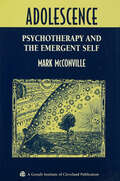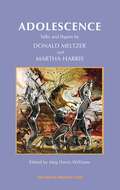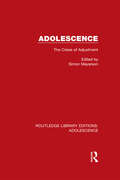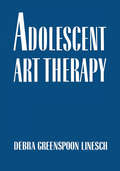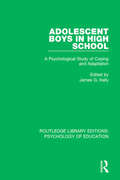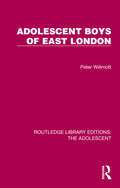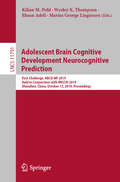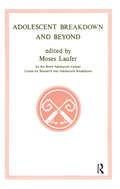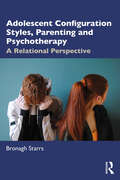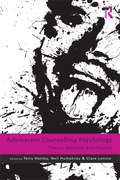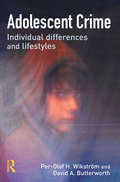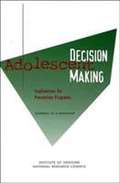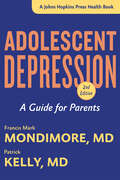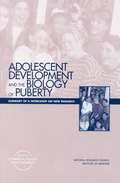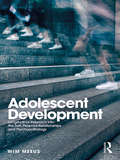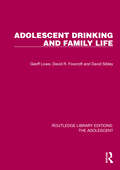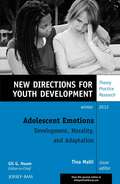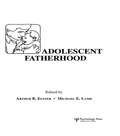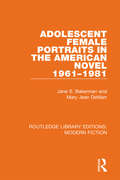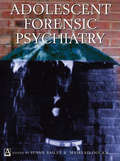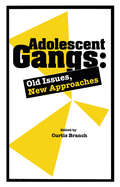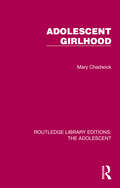- Table View
- List View
Adolescence: Psychotherapy and the Emergent Self
by Mark McConvilleMany therapists can attest to the fact that adolescents can be difficult and frustating clients-problems are seldom well defined, clearly delineated symptoms are more exception than the rule, and troubling situations often involve the entire family. Gestalt therapist Mark McConville draws on his more than twenty years of professional experience to offer clinicians an effective model for understanding and treating adolescents. He outlines the Developmental Tasks Model, which describes adolescents' struggles, "temporary insanity," and ultimately, triumph of development. He clearly demonstrates that the Gestalt therapeutic model bridges the theoretical and clinical gap, and offers an indepth exploration of the various aspects of clinical work. Adolescence offers valuable nuts-and-bolts advice on initiating therapy with adolescents who are not yet ready to do the self-reflective, exploratory work. In addition, the book examines the therapeutic method of engaging and cultivating the adolescent's emerging inner world. With perception and sensitivity, McConville explains how the clinician can guide the adolescent in the very personal and subjective process of birthing and existential self. The book details the process of the creative reorganization of the self during adolescence and explores the changes that take place in the adolescent's relationships with peers, parents, and others in the adult world. The author also tracks the interplay of intrapsychic and interpersonal boundary development and shows how this interplay manifests itself in relationships and evolves from early through late adolescence. The Gestalt model of therapy allows the clinician to make sense of the confusion of the adolescent world and map out the multiple possibilities of clinical interventions.
Adolescence: Talks and Papers by Donald Meltzer and Martha Harris
by Martha Harris Donald MeltzerThis volume contains a representative selection of talks and writings by Martha Harris and Donald Meltzer on the key developmental phase of adolescence, from their teachings both separately and together over many years. Similar books on this topic by these authors have existed for some time in Italian and in Spanish but not until now in English.
Adolescence: The Crises of Adjustment (Routledge Library Editions: Adolescence #5)
by Simon MeyersonIn this volume and its companion Adolescence and Breakdown, originally published in 1975, members of the Adolescent Department at the Tavistock Clinic and of the Tavistock Institute of Human Relations, together with other leading experts on the subject, present a unique study of adolescence. Of all living species only human beings go through a period of adolescence – and because the conflicting influences that adolescents encounter both within themselves and in the outside world are so complex, even normal adolescence is a time of crises and adjustment. While Adolescence and Breakdown traces what happens when these crises are not sufficiently well negotiated, the present volume is devoted to the dynamics and complexities of normal adolescence. The topics debated and explored include: the nature of puberty; family relationships; change and personality; adolescent sexuality; adolescents and authority; protest and politics; adolescence and creativity; groups, subcultures and countercultures in the adolescent world.
Adolescent Art Therapy
by Debra G. LineschAdolescent Art Therapy is an attempt to delineate the issues and techniques that are particular to the practice of art psychotherapy with an adolescent population. Adolescent Art Therapy provides a developmentally oriented rationale for the use of art psychotherapy with the adolescent patient.
Adolescent Boys
by Niobe Way Judy Y. ChuA flurry of best-selling works has recently urged us to rescue and protect boys. They have described how boys are failing at school, acting out, or shutting down emotionally. Lost in much of the ensuing public conversation are the boys themselves--the texture of their lives and the ways in which they resist stereotypical representations of them. Most of this work on boys is based primarily on middle class, white boys. Yet boys from poor and working class families as well as those from African American, Latino, and Asian American backgrounds need to be understood in their own terms and not just as a contrast to white or middle class boys. Adolescent Boys brings together the most up-to-date empirical research focused on understanding the development of boys from diverse racial, ethnic, and socioeconomic backgrounds. The authors show how the contexts of boys' lives, such as the schools they attend shape their identities and relationships. The research in this book will help professionals and parents understand the diversity and richness of boys' experiences.
Adolescent Boys in High School: A Psychological Study of Coping and Adaptation (Routledge Library Editions: Psychology of Education)
by James G. KellyOriginally published in 1979, the research reported in this volume is based on investigations of how tenth-grade boys cope and adapt to the high-school environment in, specifically, two high schools in suburban Detroit in 1970. In addition to information about the ways that students relate to the high school environment, this volume presents examples of how multiple research methods can be used to investigate the expression of complex person and environment relationships. This volume has been prepared to illustrate the application of an ecological point of view for research on person-environment relationships. It was hoped that the community psychologist, social psychologist, and school psychologist interested in doing research with adolescents and the high school environment would find the presentation of research methods informative and encouraging. For those readers involved in teaching and administering in secondary education, the volume was an example of how research can illustrate the ongoing personal and social characteristics of students and the high school environment.
Adolescent Boys of East London (Routledge Library Editions: The Adolescent)
by Peter WillmottOriginally published in 1966, this is a sociological study of boys growing up in East London. Previous books from the Institute of Community Studies had looked at the lives of other residents of Bethnal Green – couples with young children, middle-aged ‘Mums’, old people, widows. Now the subject is adolescent boys – a study of them not in isolation nor primarily as a ‘problem’ group but as young people moving between childhood and adulthood in the setting of a particular local community. What is it like to grow up in a district like Bethnal Green? How do the boys adjust to the process? What part is played by school, work, youth club, family? What are the boys’ relationships with their fellows and with girls? Where does delinquency fit in? To help answer such questions, a sample of 246 boys aged 14 to 20 were interviewed. The statistical analysis of this survey has been supplemented by illustrative material from diaries, tape-recorded interviews, and informal observation. The outcome is a vivid account, much of it in the boys’ own words, which was rather different from some popular views of contemporary adolescence at the time. Today it can be read and enjoyed in its historical context.
Adolescent Brain Cognitive Development Neurocognitive Prediction: First Challenge, ABCD-NP 2019, Held in Conjunction with MICCAI 2019, Shenzhen, China, October 13, 2019, Proceedings (Lecture Notes in Computer Science #11791)
by Marius George Linguraru Ehsan Adeli Kilian M. Pohl Wesley K. ThompsonThis book constitutes the refereed proceedings of the First Challenge in Adolescent Brain Cognitive Development Neurocognitive Prediction, ABCD-NP 2019, held in conjunction with MICCAI 2019, in Shenzhen, China, in October 2019. 29 submissions were carefully reviewed and 24 of them were accepted. Some of the 24 submissions were merged and resulted in the 21 papers that are presented in this book. The papers explore methods for predicting fluid intelligence from T1-weighed MRI of 8669 children (age 9-10 years) recruited by the Adolescent Brain Cognitive Development Study (ABCD) study; the largest long-term study of brain development and child health in the United States to date.
Adolescent Breakdown and Beyond
by Moses LauferThis is the second monograph published by Karnac Books on behalf of the Brent Adolescent Centre/Centre for Research into Adolescent Breakdown. Drawing on the Centre's unique pool of expertise in the field, this book contains papers giving up-to-date psychodynamic perspectives on adolescent breakdown by leading clinical experts. These cover a range of topics, such as the differing developments in male and female adolescents, and the particular problems of psychotherapeutic intervention with them. It also includes the proceedings of a conference on the subject held in October 1995. Here the issues of adolescent breakdown are discussed in the wider context which workers in the caring professions must consider. Overall, this volume provides a concise, contemporary overview of a topic whose importance is increasingly being recognized both inside and outside the psychotherapeutic community. Contributors: Anthony Bateman, Debbie Bandler Bellman, Gabrielle Crockatt, Maxim de Sauma, Domenico di Ceglie, Sara Flanders, Maurice H. Friedman, Christopher Gibson, Kevin Healy, M. Egle Laufer, Kamil Mehra, Joan Schachter, Nicholas Temple, Peter Wilson
Adolescent Configuration Styles, Parenting and Psychotherapy: A Relational Perspective
by Bronagh StarrsMental health has become the principal concern as adolescents struggle with a host of issues such as anxiety, academic pressures, gender, substances, social media, complicated family compositions and a vulnerable planet. This book provides psychotherapists with a clear theoretical understanding and practical application for navigating the increasingly complex adolescent experience as young people adjust and respond to the present- day world. Starrs presents a contemporary understanding of adolescence, identifying three principal character styles and offering experience- near descriptions of the modernday adolescent. The author demonstrates how each configuration style in adolescence elicits a predictable response in parents and examines the challenges and dilemmas facing parents in today’s world, highlighting the patterns and pitfalls which often render parental interventions ineffective. Developmentally attuned parenting strategies are outlined, pertaining to each configuration style. The in depth analysis of adolescent process and parental response has implications for the therapeutic encounter. Intervention focuses both on one- to- one work with the adolescent and parental involvement. The complexity of working with adolescents and parents who demonstrate psychological entrenchment is also outlined. This highly readable, original and exceptional contribution is suitable for psychotherapists, allied professionals and parents alike.
Adolescent Coping: Promoting Resilience and Well-Being (Adolescence and Society)
by Erica FrydenbergHow do young people cope with the multitude of difficult situations and scenarios that are associated with growing up, like anxiety and depression, as well as illness, rejection and family breakdown? How can we facilitate and encourage, through a combination of health, well-being and positive mindset, healthy development during adolescence and beyond? With a substantial focus on the positive aspects of coping, including an emphasis on developing resilience and the achievement of happiness, Erica Frydenberg presents the latest developments in the field of coping. Adolescent Coping highlights the ways in which coping can be measured and implemented in a wide range of circumstances and contexts, with suggestions for the development of coping skills and coping skills training, and it provides strong scholarly evidence for the concepts and constructs that it promotes as providing a pathway to resilience. The work is framed as an ongoing interaction between individuals and their environments as represented by the psychosocial ecological model of Bronfenbrenner. The major theories of coping are articulated that take account of the transactional model, resources theories and proactive models of coping. Areas of recent interest such as neuroscience and epigenetics are included, alongside a new chapter, ‘Cyberworld’, which provides insights on new and relevant topics such as mindfulness and the impact of social media as they relate to coping in the contemporary context. Adolescent Coping will be of interest to practitioners in psychology, social work, sociology, education and youth and community work as well as to students on courses in adolescent development in these fields.
Adolescent Counselling Psychology: Theory, Research and Practice
by Terry Hanley Neil Humphrey Clare LennieAdolescent Counselling Psychology: Theory Research and Practice provides a thorough introduction to therapeutic practice with young people. As an edited text, it brings together some of the leading authorities on such work into one digestible volume. The text is divided into three major sections.The first provides a context to therapeutic work with young people. This outlines the historical background to such work, the types of settings in which individuals work and the allied professions that they will encounter. Following on from this, the second section introduces the psychology of adolescence and provides an overview of the research into youth counselling. Finally, the third section considers more applied issues. Initially the infrastructure of counselling services is discussed before moving on to reflect upon pluralistic therapeutic practice. To end, the ways in which outcomes may be assessed in such work are described. In covering such a wide territory this text acts as an essential resource to practicing counselling psychologists and other mental health professionals. It provides a foundation to the work that individuals are undertaking in this arena and advocates that individuals enter into therapeutic work in a critically informed way. At the heart of such considerations is the need to utilise psychological theory alongside research findings to inform therapeutic decision making.
Adolescent Crime
by David A. Butterworth Per-Olof H. WikstromThis book examines young people's involvement in crime (including crimes of violence, vandalism, shoplifting, burglary and car crime) as both victims and offenders. Although adolescence is the time when involvement in crime peaks, few previous UK-based studies have attempted to provide a methodical and comprehensive understanding of adolescent offending on a city-wide basis. This book seeks a better understanding of adolescent crime by studying the relationship between individual characteristics (social bonds and morality and self-control) and lifestyles (as defined by delinquent peers, substance use and exposure to risky behaviour settings) and their joint influence on adolescent involvement in crime, against the backdrop of the juveniles' social context - taking into account family, school and neighbourhood influences. The findings of this study suggest the existence of three main groups of adolescent offenders; propensity induced offenders, life-style dependent offenders and situationally limited offenders, groups of offenders having different causal backgrounds to their crime involvement, and who therefore may warrant different strategies for effective prevention.
Adolescent Decision Making: Implications for Prevention Programs
by Institute of Medicine National Research CouncilSummary on Adolescent Decision Making.
Adolescent Depression: A Guide for Parents (A Johns Hopkins Press Health Book)
by Patrick Kelly Francis Mark MondimoreThe timely second edition of this bestselling guide will inform and encourage struggling adolescents and their families.In Adolescent Depression, psychiatrists Francis Mark Mondimore, MD, and Patrick Kelly, MD, explain that serious depression in adolescents goes beyond "moodiness." Depression is in fact an illness—one that can be effectively treated. The authors describe the many forms of depression and the many symptoms of depression in young people—from sadness to irritability, self-harm, drug and alcohol abuse, and violent rages. Incorporating the latest research from the field of adolescent psychiatry, this comprehensive and compassionate guide answers questions that many parents have, including What are the symptoms of depression in teenagers? How is depression diagnosed? What is the difference between depression and bipolar disorder, and which does my child have? How can I find the best mental health professional team for my child? What kinds of counseling and psychotherapy are available? Are medications safe, and how does a doctor choose a medication for my child? What can I do if my adolescent is using alcohol, crystal meth, marijuana, or other substances? How do autism and Asperger's syndrome, eating disorders, premenstrual dysphoric disorder, ADHD, and disruptive mood dysregulation disorder interact with depression? What should I do if I sense that my child is in danger? With all of this going on, how can I take care of myself?
Adolescent Development and School Achievement in Urban Communities: Resilience in the Neighborhood
by Patricia A. Jarvis Gary L. CreaseyThis timely volume explores essential themes, issues, and challenges related to adolescents’ lives and learning in underserviced urban areas. Distinguished scholars provide theoretically grounded, multidisciplinary perspectives on contexts and forces that influence adolescent development and achievement. The emphasis is on what is positive and effective, what can make a real difference in the lives and life chances for urban youths, rather than deficits and negative dysfunction. Going beyond solely traditional psychological theories, a strong conceptual framework addressing four domains for understanding adolescent development undergirds the volume: developmental continuities from childhood primary changes (biological, cognitive, social) contexts of development adolescent outcomes. A major federal government initiative is the development of programs to support underserviced urban areas. Directly relevant to this initiative, this volume contributes significantly to gaining a realistic understanding of the contexts and institutions within which urban youths live and learn.
Adolescent Development and the Biology of Puberty: Summary of a Workshop on New Research
by Institute of Medicine National Research CouncilAdolescence is one of the most fascinating and complex transitions in the human life span. Its breathtaking pace of growth and change is second only to that of infancy. Over the last two decades, the research base in the field of adolescence has had its own growth spurt. New studies have provided fresh insights while theoretical assumptions have changed and matured. This summary of an important 1998 workshop reviews key findings and addresses the most pressing research challenges.
Adolescent Development: Longitudinal Research into the Self, Personal Relationships and Psychopathology
by Wim MeeusThis groundbreaking book provides students and researchers with a unique overview of the longitudinal study of the development of young people from the ages of 12 to 25. It offers a comprehensive introduction into the multiple theories on the development of the self, personal relationships and psychopathology in adolescence, alongside a non-statistical overview of the many longitudinal models used to study development. The book includes key topics such as the development of the self, adolescent identity and personality; the development of parent-adolescent relationships; friendships and the understanding of others; and the development of psychosocial problems such as anxiety, depression, delinquency, aggression, and substance use. Meeus highlights multiple findings showing how these processes are integrated and identifies eight fundamental patterns of adolescent development to help determine why most adolescents develop into mature and organized individuals towards the end of this life stage, whilst a substantial minority show an inability to mature. It is essential reading for graduate students and researchers in adolescent development and anyone seeking to use longitudinal research methodology in the social and behavioral sciences.
Adolescent Drinking and Family Life (Routledge Library Editions: The Adolescent)
by David Sibley Geoff Lowe David R. FoxcroftOriginally published in 1993, Adolescent Drinking and Family Life portrays teenage drinking, not as a symptom of pathology, but as a perfectly normal developmental phase within the context of the home environment. Drinking is predominantly social behaviour and the family is seen as a major agent of socialization. The authors have therefore explored family dynamics and the influence which the home environment has upon adolescent drinking to come up with a new theoretical model. A major feature of this approach is the interaction of ideas from family life psychology and human geography. The authors present a typology of domestic regimes illustrated by case studies of boundary enforcement and transgression. The general theme of boundary transgression, applied here to both the psychosocial environment and built form, represents an interesting new theoretical perspective. The integration of these two fields is an innovation which should stimulate further interdisciplinary work in adolescence and addiction research. Adolescent Drinking and Family Life will be interesting to researchers and practitioners in adolescence, family dynamics, and alcohol as well as any social scientist with an interest in the link between behaviour and the home environment. This new approach had important implications for health education and for interventions concerned with adolescent alcohol use at the time. Today it can be read in its historical context.
Adolescent Emotions: New Directions for Youth Development, Number 136 (J-B MHS Single Issue Mental Health Services #123)
by Tina MaltiTake an in depth look at how emotions relate to adolescents’ decision making, reasoning, and behavior in morally relevant situations. It provides a summary of current research on emotions, morality, and adaptive behaviors. Furthermore, it discusses new approaches to research on emotions, morality, and socially adaptive behavior in adolescence. By doing so, the articles provide new insights into adolescents’ emotional and moral development and show how emotions contribute to the way adolescents negotiate, resolve, and adapt to the moral and social conflicts that inevitably occur in their everyday lives. By integrating innovative perspectives from developmental, educational, and clinical research, this volume has much to offer for researchers, youth practitioners, and educators. This is the 136th volume of New Directions for Youth Development, the Jossey-Bass quarterly report series dedicated to bringing together everyone concerned with helping young people, including scholars, practitioners, and people from different disciplines and professions.
Adolescent Fatherhood
by ARTHUR B. ELSTER and MICHAEL E. LAMBFirst published in 1986. Routledge is an imprint of Taylor & Francis, an informa company.
Adolescent Female Portraits in the American Novel 1961-1981 (Routledge Library Editions: Modern Fiction)
by Jane S. Bakerman Mary Jean DeMarrOriginally published in 1983, this title lists and annotates reference sources which will help readers select primary materials useful in studies of the literary portraits of women and their societal roles. The years 1961 to 1981 were set as boundaries for this volume because the author’s initial research revealed that a twenty-year span was a manageable unit, because the novels published between those dates yielded abundant materials for such a reference work, and because significant changes in the way portraits of adolescent females were being drawn took place during the period – for example, sex-role stereotyping became a shade less prevalent, young women’s sexuality was discussed more forthrightly, and some topics (such as single women’s pregnancies and lesbianism) were treated more overtly, sometimes less judgementally.
Adolescent Forensic Psychiatry
by Susan Bailey Mairead DolanAdolescent Forensic Psychiatry discusses a broad range of issues based around the psychiatric needs of adolescents and how these relate to offending behaviour. Its well-structured approach looks at assessment, treatment and outcomes for different disorders and highlights the importance of effective interaction between specialist agencies. Services
Adolescent Gangs: Old Issues, New Approaches
by Curtis W. BranchPublished in 1998, Adolescent Gangs is a valuable contribution to the field of Counseling and School Therapy.
Adolescent Girlhood (Routledge Library Editions: The Adolescent)
by Mary ChadwickOriginally published in 1932, Adolescent Girlhood set out to give a general view of the more everyday problems a girl might encounter during adolescence. Both at home and at school and those problems that had, despite their prevalence, not gained as much attention or understanding as they merited or required. It was assumed that readers interested in development would have had some knowledge of the general concepts of psychology and psychoanalysis, given the prominence of discoveries in these fields over the previous ten to twenty years. <p><p> It starts with some history of the adolescent girl, including their representation in literature and goes on to cover issues such as physical changes, as well as psychological and emotional expectations. Today it can be read and enjoyed in its historical context. <p><p> This book is a reissue first published in 1932. The language used is a reflection of its era and no offence is meant by the Publishers to any reader by this re-publication.
